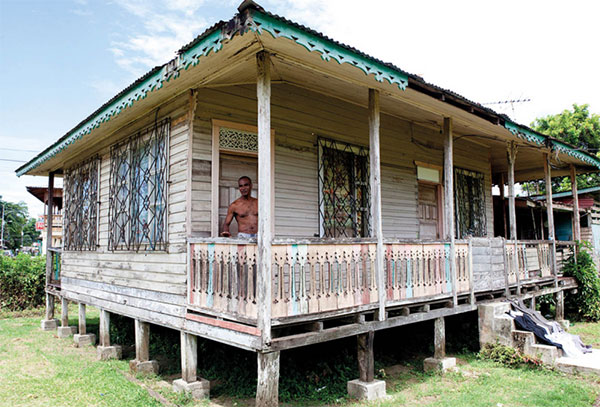Cahuita
Cahuita £ [map] is a small scruffy town of faded but dignified-looking wooden houses, once painted bright colors that are now soft pastels, with a touch of Caribbean whimsy in the gingerbread details. Young travelers from Europe, Canada, and the US, oblivious to more modest local sensibilities, amble along the beaches and roadways in bright, scanty beachwear.
The main activity in Cahuita is snorkeling and The Snorkeling House (www.snorkelinghouse.com) will get you peering under the waves in no time. For tours and excursions farther afield, Cahuita Tours (www.cahuitatours.com) is an experienced, reliable tour operator in Cahuita.
To the immediate south of Cahuita is Parque Nacional Cahuita (daily 8am–4pm), famous for its fine, sandy beach and coral reef. The reef extends 500 meters (1,500ft) out to sea from Punta Cahuita and offers great snorkeling, although the point of the reef was severely displaced during an earthquake. There are many species of tropical fish, crabs, lobsters, sea fans, anemones, sponges, seaweed, and innumerable other marine creatures to observe amidst the coral formations. You can admire it all and keep your feet dry aboard a glass-bottomed boat, or you can swim from the main entrance to the park at Puerto Vargas, 5km (3 miles) south of town. Camping is permitted in the Puerto Vargas sector, which has restrooms, showers, and picnic tables.
Puerto Viejo
Heading south toward Puerto Viejo, along a partially paved road that runs parallel to the beach, you pass houses of every style and class, but there is something magical about the Caribbean air that gives even the humblest shack a picturesque quality when it is set amidst tall coconut trees. Puerto Viejo de Talamanca $ [map] is a hodgepodge of dilapidated wooden houses amidst tall grass. At the entrance to the town, you pass a rusted-out barge anchored just off the black-sand beach.

Traditional wooden architecture, Cahuita.
Corrie Wingate/Apa Publications
Puerto Viejo is famous in surfing circles for the Salsa Brava, a fast, explosive and hollow wave that breaks over the reef from December through April and again in June and July. It attracts surfers from all over the world. At other times of the year the sea is quiet, particularly inside the reef, and good for snorkeling.
If you want to stay near town, where the action is, especially at night, try the Casa Verde Lodge (tel: 2750 0015), a tidy, Swiss-run collection of colorfully decorated cabinas set in a lush garden. It’s cheap and cheerful and in great demand, so make a reservation well in advance. To catch the reggae beat, head to Johnny’s Place on a Friday or Monday night. For salsa and merengue, The Lazy Mon at Stanford’s, practically on the beach, is the place to go on weekend nights.
South of town there are cabinas and sophisticated hotels and restaurants lining the road across from beautiful stretches of white sand beach edged by palm and beach almond trees, like the award-winning Cariblue (www.cariblue.com) at Playa Cocles, and the chic boutique hotel Le Cameleon (tel: 2750 0501; www.lecameleonhotel.com).
North-central Costa Rica
The region to the northeast of San José corresponds roughly to the area known as the Northern Zone, where the landscape is lush and agricultural for the most part. The main attractions for visitors are the spectacular Arenal Volcano with its surrounding hot springs and spas, and some remote rainforest reserves.
Monteverde Cloud Forest
The journey from the lowland, dry tropical forest to the misty, mountain cloud forests of Monteverde % [map] isn’t far as the crow flies. By road, you turn off the Interamericana Highway at the Rancho Grande exit at Km 133, heading for Sardinal. Monteverde sits atop the Continental Divide, and, despite some road improvements, the last 37km (21 miles) are still challenging, allow up to an hour to make the slow, winding ascent up a mostly unpaved road.
Tip
A few of the more common expressions on the Caribbean coast: ‘Wh’appen?’ (‘What’s happening?’) is the usual form of greeting, replacing the ‘Adiós’ of the Central Valley. ‘How de morning?’ is ‘Good morning’ and ‘Go good’ is ‘Take care.’ The polite form of address is to use someone’s first name preceded by Mr or Miss.
Despite the ordeal to get here, every year tens of thousands of people make the climb, primarily to visit the Reserva Biológica del Bosque Nuboso de Monteverde (www.reservamonteverde.com; daily 7am–4pm; night tours by reservation). To protect the flora and fauna and the trails of this popular preserve, visitors are limited to 220 at any given time – which means you may have to wait your turn. You should book at least one night’s accommodations in advance; to get the best out of the area you need to stay three days.
Monteverde is much more than an opportunity to spot a resplendent quetzal, the most colorful and spectacular bird in the tropics. This misty, verdant, high-altitude cloud forest is home to a multitude of diverse creatures: 448 species of birds identified so far, about 700 species of butterflies, 3,000 species of plants, and 130 species of mammals, of which 70 are bats. Pick up a checklist and map at the Visitors’ Center. Tours with excellent naturalist guides are available.